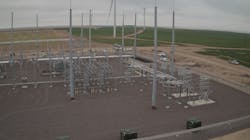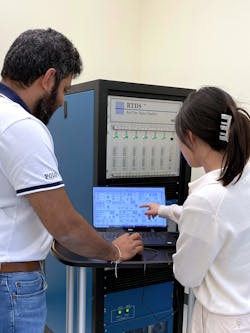Xcel Energy's Colorado Wind Farm Integration with the Grid
As anyone who has driven between Denver and Kansas City knows, there’s a lot of wind on Colorado’s eastern plains. In this area, you’ll find five wind farms which together generate up to 1,400 MW of power for Xcel Energy customers. That’s enough energy to power more than 750,000 homes. These resources are connected to Xcel Energy’s Missile Site Substation through a 150-mile-long, radial 345 kV transmission line. Collectively, the transmission line and the interconnected wind farms comprise what is known as the Rush Creek Gen Tie.
Wind can be a fickle and capricious resource. It blows when it wants to and as hard as it wants to. The variable nature of wind, coupled with the long transmission line and the characteristics of inverter-based generation can lead to undesirable reactive power swings as the generation ramps up and down.
For a single wind farm, a well-tuned droop control system often can handle these voltage swings. But as the scale and number of closely coupled wind farms increase, the controls needed to maintain system integrity become more complex and often require operators to manually intervene.
To manually maintain stability on the Rush Creek Gen Tie, operators need a comprehensive understanding of the transmission system characteristics and wind farm voltage schedules and capabilities. Preliminary studies indicated that the characteristics of the Rush Creek Gen Tie would create a lot of challenges for system operators. This effort would include frequent monitoring of generation facility real power and the var support provided by the available reactive resources. It was expected that voltage setpoints would need to be routinely adjusted as the real power fluctuated to keep the Missile Site Substation voltage and the reactive power flows within established operating bands.
Xcel Energy wanted a better way to manage this complex radial system and maintain efficiency and stability. The utility teamed with POWER Engineers, TransGrid Solutions and Mitsubishi Electric Power Products to design an automatic, coordinated voltage control system for the wind farm transmission system. Called an Automatic Voltage Setpoint Optimizer (AVSO), this control device performs voltage adjustments that would otherwise be performed manually to improve the power factor and to reduce the risk of significant or oscillatory reactive power swings among the wind farms.
In operation since August 2021, the AVSO has narrowed the voltage band at Missile Site Substation, improved the operating voltage profile on the facilities, reduced the amount of circulating reactive power present on the system and reduced operator workload. By automating routine voltage coordination tasks, the utility’s transmission system operators have more time to focus on other critical and unplanned system events.
Controller Need Identified
The Rush Creek Gen Tie system comprises the 380 MW Rush Creek I, 220 MW Rush Creek II, 268 MW Cheyenne Ridge West, 230 MW Cheyenne Ridge East, and 300 MW Bronco Plains wind farms. These wind farms use Type III and Type IV turbines. Xcel Energy owns and operates all the wind farm and transmission line facilities except Bronco Plains and its line connecting to the Shortgrass Substation. In addition to the generation facilities, several switched fixed capacitor and reactor banks and a STATCOM are connected to the transmission line.
The initial radial system, built in 2018, connected the Rush Creek I and II wind farms to the Missile Site Substation, where the radial system connected to the Xcel Energy network. (The substation gets its name from a former national defense site of the Cold War Era.) Most of the rest of the system was put into service in 2020.
An interesting feature of the Rush Creek Gen Tie is that the voltage at the Missile Site Substation must be held within a narrow bandwidth while each wind farm can vary independently depending on its individual real power output and the aggregate flow on the transmission line.
To provide optimal and stable performance, operators manually sent voltage setpoints they were trying to achieve to each wind farm and the STATCOM. This increased the time operators spent on regulating the system, especially during increasing winds when line-charging characteristics changed dramatically. Voltages at each facility had to be independently evaluated and cross-referenced against the Missile Site Substation voltage before making any voltage reference changes. Automating these tasks clearly could reduce the risk of not correctly coordinating the assets, as well as lower operator workload.
Given the distances between the generating locations and diversity of wind across the region, it is possible to have significant reactive power swings from different facilities along the Rush Creek Gen Tie transmission tie line. Generators closer to the Missile Site Substation had far greater influence on voltage regulation than those near the remote end of the transmission line. Also, differences in turbine and control technologies among the generating facilities yielded unsatisfactory distribution of reactive power along the line.
Detailed system modeling further showed the possibility of wind farm overvoltage conditions tripping protective devices and disconnecting from the transmission line. There was also the possibility devices could trip in response to system disturbances and conflicts from control interactions. Transmission line characteristics, low short-circuit ratio, and initial wind farm and turbine settings increased the potential for issues, especially during system disturbances. It was found that each wind farm voltage set point needed to be assigned within a particular range to maximize ride-through performance in response to system disturbances.
These issues supported the view that the system would benefit from a single controller regulating the reactive power output of all the wind farms connected to the Rush Creek Gen Tie. A single controller also could coordinate the farms’ voltage references with the dynamic and static assets to maintain the voltage where the radial system connected to the Xcel Energy network.
AVSO Goals Planned
The goals the AVSO project team outlined during planning included:
- Regulating transmission voltage at the Missile Site Substation within a band that users could set. It also needed to maintain healthy voltages at the generation facilities and substation busses.
- A consistent design approach that would be easy to use, troubleshoot and expand.
- Alignment of controller hardware selections with existing utility equipment standards to reduce engineering and field overhead during design, installation and commissioning.
- Integration of standalone controllers which control the switched fixed capacitor and reactor bank assets.
- Automatic operation, with little to no input from operators.
Extensive modeling determined the operating requirements of the AVSO. Modeling analysis included quasi-steady state, steady state contingency and transient studies. The project team performed these studies across a variety of system conditions, including low and high generation cases, generation ramp up and ramp down, facility outages, and system disturbances. The team also conducted the studies in cases where part of the system was at high output while others were at low output to simulate the diversity of wind across the various facilities.
With the high variability in power from the wind farms, the team designed the AVSO to handle expected operating scenarios and lower the potential for reactive power oscillations within the system. The AVSO acts as a steady-state system optimizer that adjusts the voltage references to each wind farm and STATCOM droop controller based on voltage deviations from the Missile Site Substation voltage setpoint.
The project team designed the AVSO’s operating parameters to be highly customizable and modifiable at any time. Operators can define custom high and low limits for voltage regulation for each facility as well as define the size of the discrete voltage step issued by the AVSO. An operator can manually send an override voltage reference to any facility at any time without interrupting automatic operation if needed to adjust reactive power flows. System operators can send all AVSO setpoints and parameters remotely through dedicated interfaces.
Operators at the Xcel Energy control center receive feedback and alarms. Under normal operation, the AVSO autonomously makes voltage reference adjustments to maintain the point-of-use voltage. System operators can enable or disable any facility or asset from AVSO control at any time. This allows continuity of control over several facilities in the event of wind farm maintenance, testing or outages. The AVSO regulates system voltage in conjunction with dedicated automatic voltage controllers, which command operation of switched reactive assets.
The wind farms and reactive assets closer to the Missile Site Substation affect the point-of-use voltage more than those farther away. The facilities closest to the substation are also the first to reach their reactive power limits. As the available reactive power of a facility drops below the previously determined threshold, the voltage reference step size is proportionally reduced until it reaches zero and the facility reaches its maximum reactive power capability. As a result, generation facilities farther away from Missile Site Substation provide an increased share of the reactive power needed to maintain the point-of-use voltage. Facilities closer to the substation retain more dynamic reactive capability to support system transient events.
Redundant Communication System
Because of the importance of maintaining the reliability of the AVSO system, the design team implemented a dedicated high-speed fiber communication network, and redundant dedicated sensor and processor hardware. The fiber communication network, along with additional copper backup paths, provides redundancy, delivers telemetry to the AVSO, and carries system commands to each controlled facility. This communication system carries only AVSO communication traffic, reducing bandwidth requirements and potential packet loss. The system allows automatic packet forwarding using connectivity
fault management in the event of a disruption to part of the communication network.
The team designed the AVSO equipment and architecture with physical redundancy, isolation from other systems and dedicated hardware. Automatic failover features were also incorporated to identify and compensate for hardware and communication failures. Because the Missile Site Substation is the critical point of control, it also has enhanced security features.
Extensive Simulations Conducted
Because the Rush Creek system was already operating when Xcel Energy installed the AVSO, the team didn’t conduct initial testing on the live transmission system. Instead, the project team developed an overall system model containing an equivalent of the Xcel Energy network, the radial transmission lines, each wind farm and the STATCOM. The team loaded the actual AVSO controller program into the controller hardware, which they then integrated into the digital model. This allowed for hardware-in-the-loop testing using the RTDS Simulator.
The team subjected the AVSO to extensive simulations representing real-world operating scenarios. Testing used a wide range of operating scenarios that covered voltage changes, power ramps, facility trips, line trips, energization, loss of signals, continuous operation, and primary and secondary controller change-over.
During the testing, the team identified ways to improve the AVSO algorithm to refine the performance of the devices and improve communication mapping. Testing also demonstrated the benefits of the AVSO and automatic voltage controllers, and provided a better understanding of AVSO operation under different conditions. By conducting witness tests, the utility’s system operators also gained increased confidence that the AVSO and separate automatic voltage controllers would perform as they were designed to do.
The team also created a detailed commissioning test plan and executed it on-site as each component of the AVSO was placed into service. The test plan culminated with full-scale testing of the entire Rush Creek Gen Tie system under AVSO control. Commissioning procedures consisted of communication verification, data source verification, setpoint verification, reference verification and functional testing.
Switching Operations Reduced
The 345 kV switched fixed capacitor banks at Missile Site saw an 83% reduction in switching operations after the AVSO was placed in service. This reduction was due to tighter regulation at each of the generating facilities and their coordination with the voltage cut-in points of the automatic voltage controller system for the switched fixed reactive assets. Reduction in high-voltage cap bank operation is expected to yield cost savings through increased intervals between breaker maintenance and prolonged equipment life.
The benefits of implementing the AVSO also included savings in operational maintenance costs and reducing operators’ routine workloads. This has allowed operators to focus on critical and unplanned system events. RTDS and field testing provided operators and engineering staff confidence that the AVSO would handle unique operating scenarios. Developing and implementing the AVSO demonstrates how engineering problems can be addressed as integrating inverter-based resources become more widespread at the utility scale.
Aaron Wilson ([email protected]) is a Senior Manager of Substation Engineering at Xcel Energy and is a registered professional engineer with more than 30 years of diverse T&D experience. He is a member of the IEEE and is currently involved with several IEEE standards working groups including serving as the current chair for IEEE 998, Guide for Direct Lightning Stroke Shielding of Substations.
Ben Ryan ([email protected]) is a Project Engineer experienced with SCADA, power delivery systems analysis, protection schemes, communications troubleshooting and automation. His range of project contributions include automation controllers, power system control and protection, and grounding analysis.
Scott Ghiocel ([email protected]) is a Managing Principal Consultant for Mitsubishi Electric Power Products. He specializes in electric power systems, including modeling, monitoring, stability, and control of transmission systems and smart grids. He has designed and deployed real-time energy management software applications for power system operations and control using synchronized phasor measurements, including state estimation, voltage stability, and reactive power dispatch using flexible AC transmission system controllers.
Hiranya Suriyaarachchi ([email protected]) is a Principal Engineer for TransGrid Solutions. He is an electrical engineer with more than 15 years of experience in all aspects of power system services including studies, equipment services and education. He is an expert in VSC HVDC transmission and sub-synchronous interactions between a doubly fed induction generator equipped wind farms and series compensated transmission lines. He has led numerous RTDS AC system modelling activities for various HVDC and FACTS manufacturers including one of the world’s largest RTDS AC system models and several HIL testing for TransGrid Solutions.
For More Information
POWER Engineers | www.powereng.com
TransGrid Solutions | https://transgridsolutions.com
Mitsubishi Electric Power Products | www.meppi.com
About the Author
Aaron Wilson
Aaron Wilson ([email protected]) is a Senior Manager of Substation Engineering at Xcel Energy and is a registered professional engineer with more than 30 years of diverse T&D experience. He is a member of the IEEE and is currently involved with several IEEE standards working groups including serving as the current chair for IEEE 998, Guide for Direct Lightning Stroke Shielding of Substations.
Ben Ryan
Ben Ryan ([email protected]) is a Project Engineer experienced with SCADA, power delivery systems analysis, protection schemes, communications troubleshooting and automation. His range of project contributions include automation controllers, power system control and protection, and grounding analysis.
Scott Ghiocel
Scott Ghiocel ([email protected]) is a Managing Principal Consultant for Mitsubishi Electric Power Products. He specializes in electric power systems, including modeling, monitoring, stability, and control of transmission systems and smart grids. He has designed and deployed real-time energy management software applications for power system operations and control using synchronized phasor measurements, including state estimation, voltage stability, and reactive power dispatch using flexible AC transmission system controllers.
Hiranya Suriyaarachchi
Hiranya Suriyaarachchi, ([email protected]) is a Principal Engineer for TransGrid Solutions. He is an electrical engineer with more than 15 years of experience in all aspects of power system services including studies, equipment services and education. He is an expert in VSC HVDC transmission and sub-synchronous interactions between a doubly fed induction generator equipped wind farms and series compensated transmission lines. He has led numerous RTDS AC system modelling activities for various HVDC and FACTS manufacturers including one of the world’s largest RTDS AC system models and several HIL testing for TransGrid Solutions.



